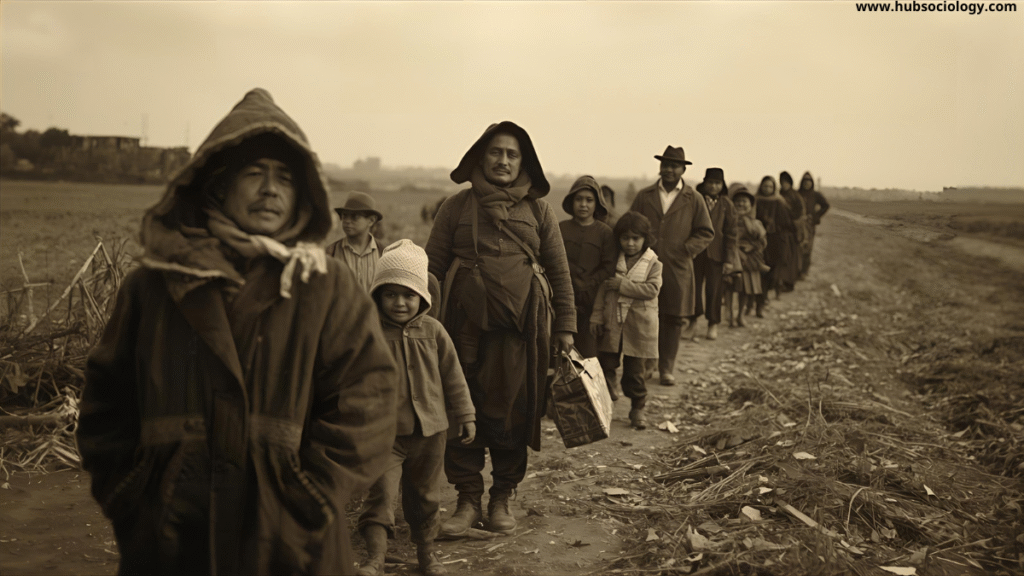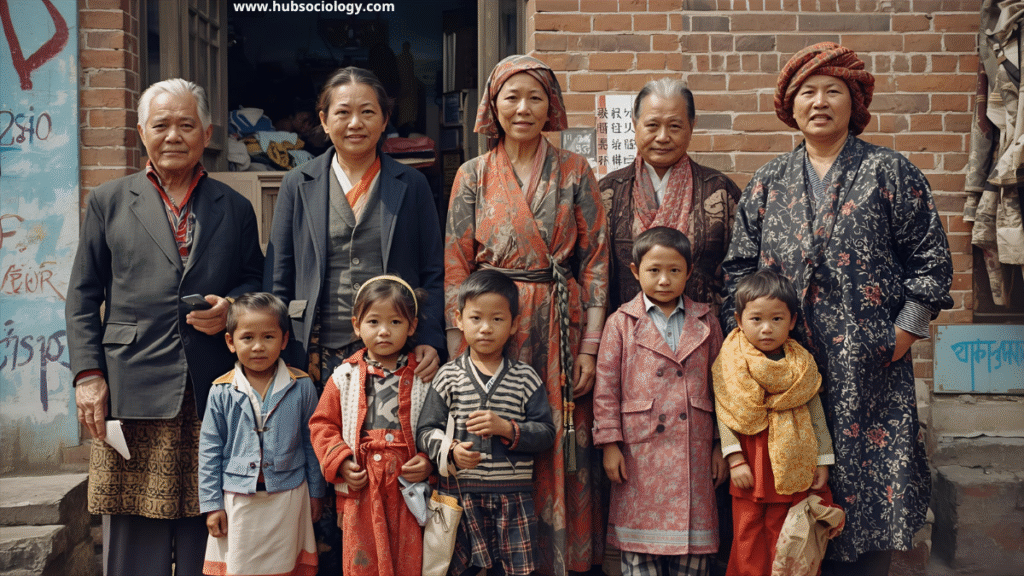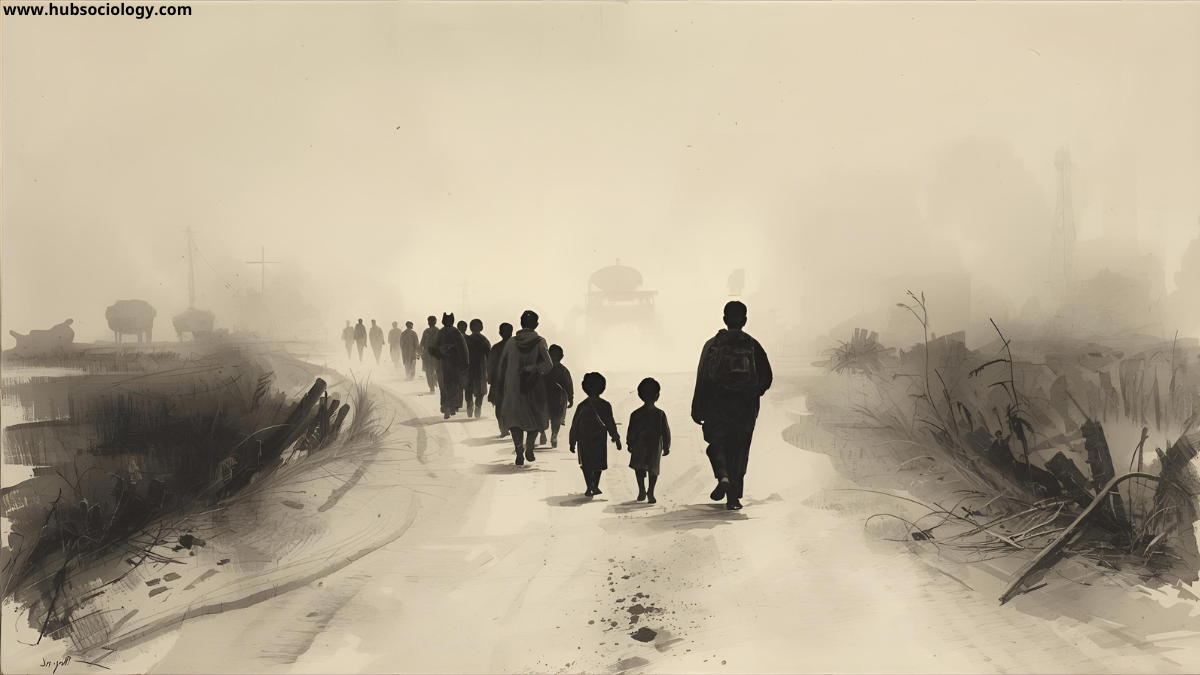Introduction on Post-Independence Migration
Migration has always been a defining feature of human history, shaping societies, cultures, and economies. The post-independence era, particularly after the mid-20th century, witnessed large-scale migration flows from newly decolonized nations in Asia, Africa, and the Caribbean to Western countries such as the United States, Canada, the United Kingdom, and Western Europe. Unlike colonial-era forced migrations such as slavery and indenture, post-independence migration was driven by complex sociological factors including economic opportunities, education, social mobility, political instability, and cultural globalization. These movements not only transformed the lives of migrants but also reshaped the social fabric of both the sending and receiving societies.

Historical Context of Post-Independence Migration
Following the end of colonial rule in countries across Asia, Africa, and the Middle East, Western nations entered a new phase of nation-building, modernization, and industrial growth. Many of these countries, especially in Europe, faced labor shortages after World War II and actively recruited workers from their former colonies. For example:
- The United Kingdom welcomed migrants from India, Pakistan, Bangladesh, and the Caribbean under the British Nationality Act (1948), which granted Commonwealth citizens free entry.
- France encouraged migration from North and West Africa to rebuild its economy.
- Canada and Australia shifted their restrictive immigration policies, opening doors to skilled and semi-skilled migrants from Asia and beyond.
At the same time, newly independent nations were struggling with unemployment, poverty, and social upheavals, which pushed individuals to seek opportunities abroad. Thus, the convergence of “push” and “pull” factors fueled significant migration flows to the West.
Push and Pull Factors in a Sociological Lens
From a sociological perspective, migration flows are not merely demographic shifts but are embedded in social structures and cultural dynamics.
Push Factors included:
- Economic hardship: Limited job opportunities in post-colonial economies.
- Political instability: Civil wars, authoritarian regimes, and ethnic conflicts.
- Social inequality: Caste, class, and ethnic discrimination drove people to pursue fairer systems abroad.
Pull Factors were:
- Employment demand: Western economies required workers in industries, healthcare, and services.
- Educational opportunities: Scholarships and universities in the West attracted ambitious students.
- Social mobility: The dream of upward mobility and improved living standards.
- Diaspora networks: Family and community ties abroad created support systems for new migrants.
Thus, migration was not simply an economic decision but a social strategy shaped by aspirations, identities, and structural inequalities.
Forms of Post-Independence Migration
Sociologically, migration flows can be categorized into different forms:

- Labor Migration
Migrants filled low-paid industrial and service jobs in Western countries. South Asians in Britain often worked in textile mills, transport, and healthcare, while North Africans in France worked in construction and factories. - Professional Migration
A significant “brain drain” occurred as doctors, engineers, scientists, and teachers from newly independent countries migrated to the West. For example, Indian doctors became crucial to the UK’s National Health Service in the 1960s and 70s. - Educational Migration
Students from Asia and Africa traveled to Western universities, sometimes staying permanently. This not only enriched the academic spaces of the West but also created globalized professional classes. - Refugee and Asylum Migration
Political crises, such as the Ugandan expulsion of Asians in 1972 or the civil wars in Sri Lanka and Afghanistan, pushed entire communities to seek asylum in Western nations. - Family Reunification
Once initial migrants settled, policies in many Western countries allowed family members to join them, leading to permanent communities.
Sociological Theories of Post-Independence Migration
Several sociological perspectives help explain these flows:
- Functionalist Perspective: Migration is seen as fulfilling labor market needs in Western societies while also providing remittances for sending nations. It creates interdependence between developed and developing countries.
- Conflict Perspective: Migration reflects global inequalities. Post-colonial migrants often occupied marginalized positions in host societies, facing racism, exclusion, and exploitation.
- World Systems Theory: Migration is linked to global capitalism, where former colonies remain economically dependent and supply cheap labor to the industrialized West.
- Network Theory: Migration flows continued as diasporic communities created support systems for new migrants, reducing risks and facilitating settlement.
Cultural and Social Consequences on Post-Independence Migration
Migration flows brought significant sociocultural transformations:
- Multiculturalism in the West
Migrants enriched Western societies with diverse languages, foods, religions, and cultural practices. Cities like London, Toronto, and New York became multicultural hubs. - Identity Negotiations
Migrants often struggled with hybrid identities, balancing traditional cultural values with Western lifestyles. Second-generation immigrants especially faced issues of assimilation versus cultural retention. - Racism and Discrimination
Migrants frequently encountered structural racism, social exclusion, and stereotyping. Events such as the UK’s 1958 Notting Hill riots and the discrimination against Algerians in France highlight these challenges. - Diasporic Communities
Strong diasporic networks fostered solidarity, cultural preservation, and political activism. They also played crucial roles in lobbying for immigrant rights and influencing policies in both host and home countries.
Impact on Sending Countries
The sociological effects of migration were equally significant in the home nations:
- Remittances: Migrants’ financial contributions supported families and national economies.
- Brain Drain: Skilled professionals leaving caused shortages in developing countries.
- Cultural Exchange: Returning migrants introduced new ideas, lifestyles, and technologies.
- Transnationalism: Migrants maintained ties through communication, remittances, and even political influence, blurring boundaries between home and host societies.
Migration and Globalization
Post-independence migration flows were closely tied to globalization. Migrants served as bridges between societies, facilitating cultural exchange, trade, and knowledge flows. At the same time, globalization reinforced inequalities, as Western countries often benefited more from the skills and labor of migrants than the sending nations.
Challenges and Sociological Debates
The post-independence migration phenomenon continues to raise critical sociological debates:
- Integration vs. Assimilation: Should migrants blend into host societies or retain distinct cultural identities?
- Citizenship and Belonging: Many migrants face precarious citizenship statuses, questioning who truly “belongs” in Western nations.
- Ethnic Inequalities: Migrant communities often face overrepresentation in low-income sectors, perpetuating cycles of inequality.
- Generational Gap: Second and third-generation migrants negotiate complex cultural expectations, sometimes leading to identity conflicts.
Conclusion
Post-independence migration flows to Western countries represent more than demographic shifts; they embody the complex interplay of history, economy, politics, and culture. From a sociological perspective, these movements reveal how global inequalities, diasporic networks, and identity negotiations shape modern societies. Migrants contributed not only to the rebuilding of Western economies but also to the cultural richness and pluralism of host societies. At the same time, they navigated discrimination, identity struggles, and transnational ties that continue to define the global social landscape.

In essence, post-independence migration has been both a challenge and an opportunity, creating societies that are increasingly diverse, interconnected, and dynamic—an enduring legacy of the post-colonial world order.
Do you like this this Article ? You Can follow as on :-
Facebook – https://www.facebook.com/hubsociology
Whatsapp Channel – https://whatsapp.com/channel/0029Vb6D8vGKWEKpJpu5QP0O
Gmail – hubsociology@gmail.com
Topic-related questions
5 Marks Questions (Short Answer)
- Define post-independence migration in a sociological sense.
- Mention two push and two pull factors of post-independence migration.
- What role did the British Nationality Act (1948) play in migration flows?
- Explain the term brain drain in the context of post-independence migration.
- List two major challenges faced by migrants in Western societies.
10 Marks Questions (Medium Answer)
- Examine the role of labor shortages in Western countries in shaping post-independence migration flows.
- Discuss the cultural and social consequences of post-independence migration in Western societies.
- How do sociological theories such as Functionalism and Conflict Theory explain post-independence migration?
- Explain the significance of diaspora networks in sustaining migration flows after independence.
- Analyze the impact of remittances and transnational ties on sending countries.
15 Marks Questions (Long Answer/Essay Type)
- Critically evaluate the sociological dimensions of post-independence migration from Asia and Africa to Western countries.
- Discuss how post-independence migration flows reshaped the identity and social structures of both migrants and host societies.
- Examine the relationship between globalization and post-independence migration flows, with suitable examples.
- Analyze the impact of racism, discrimination, and identity negotiations on migrants in Western societies.
- Assess the role of post-independence migration in creating multiculturalism in Western countries, highlighting both challenges and opportunities.
